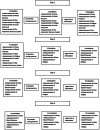The effect of transcutaneous auricular vagus nerve stimulation on cycling ergometry and recovery in healthy young individuals
- PMID: 37974551
- PMCID: PMC10726880
- DOI: 10.1002/brb3.3332
The effect of transcutaneous auricular vagus nerve stimulation on cycling ergometry and recovery in healthy young individuals
Abstract
Background: It is aimed to examine the potential benefits and effects of the use of transcutaneous auricular vagus nerve stimulation (VNS) for sporting purposes on recovery, fatigue, and sportive performance level.
Methods: In this study, 90 people between the ages of 18-23 were participated. They were randomly divided into three groups as bilateral sham, unilateral left, and bilateral VNS. A 4-day protocol was applied to the participants. Cycling exercise was performed with maximum performance for 30 min under the same watt load. Pulse, systolic and diastolic blood pressure, distance, pain, fatigue, lactic acid level, and autonomic nervous system were evaluated.
Results: Within the groups, there was a statistically significant difference between the data (p < .05) except for the distance covered parameter. When we compare the groups, in addition to the distance traveled in all groups, there is no statistically significant difference in the 1st day 1st measurement and 2nd measurement data of all parameters (p > .05 When we compared the data according to days, there was a statistically significant difference between bilateral stimulation (BS) and unilateral stimulation, only pain and fatigue levels (p < .05).
Conclusion: In our study, we saw that BS application gave positive results in reducing pain and fatigue due to cycling exercise compared to other applications. Similar results were obtained when we evaluated the data on a daily basis. We believe that VNS will be beneficial in reducing pain and fatigue, especially during and after the competition halftime.
Trial registration: ClinicalTrials.gov 05778058.
Keywords: auricular; cycling ergometry; recovery; transcutaneous; vagus nerve stimulation.
© 2023 The Authors. Brain and Behavior published by Wiley Periodicals LLC.
Conflict of interest statement
The authors declare that they have no known conflicts of interest or personal relationships that could have appeared to influence the work reported in this paper. The authors contributed equally to the article. Final draft by all authors.
Figures
Similar articles
-
Vagus nerve stimulation for partial seizures.Cochrane Database Syst Rev. 2015 Apr 3;2015(4):CD002896. doi: 10.1002/14651858.CD002896.pub2. Cochrane Database Syst Rev. 2015. Update in: Cochrane Database Syst Rev. 2022 Jul 14;7:CD002896. doi: 10.1002/14651858.CD002896.pub3. PMID: 25835947 Free PMC article. Updated.
-
Transcutaneous electrical nerve stimulation (TENS) for fibromyalgia in adults.Cochrane Database Syst Rev. 2017 Oct 9;10(10):CD012172. doi: 10.1002/14651858.CD012172.pub2. Cochrane Database Syst Rev. 2017. PMID: 28990665 Free PMC article.
-
Prescription of Controlled Substances: Benefits and Risks.2025 Jul 6. In: StatPearls [Internet]. Treasure Island (FL): StatPearls Publishing; 2025 Jan–. 2025 Jul 6. In: StatPearls [Internet]. Treasure Island (FL): StatPearls Publishing; 2025 Jan–. PMID: 30726003 Free Books & Documents.
-
Transcutaneous electrical nerve stimulation (TENS) for neuropathic pain in adults.Cochrane Database Syst Rev. 2017 Sep 14;9(9):CD011976. doi: 10.1002/14651858.CD011976.pub2. Cochrane Database Syst Rev. 2017. PMID: 28905362 Free PMC article.
-
Brainstem neuronal responses to transcutaneous auricular and cervical vagus nerve stimulation in rats.J Physiol. 2024 Aug;602(16):4027-4052. doi: 10.1113/JP286680. Epub 2024 Jul 19. J Physiol. 2024. PMID: 39031516 Free PMC article.
Cited by
-
The vagus nerve: a cornerstone for mental health and performance optimization in recreation and elite sports.Front Psychol. 2025 Jul 11;16:1639866. doi: 10.3389/fpsyg.2025.1639866. eCollection 2025. Front Psychol. 2025. PMID: 40718569 Free PMC article. Review.
-
Autonomic neuromodulation for cardiomyopathy associated with metabolic syndrome - Prevention of precursors for heart failure with preserved ejection fraction.Hypertens Res. 2024 Dec;47(12):3318-3329. doi: 10.1038/s41440-024-01886-2. Epub 2024 Sep 11. Hypertens Res. 2024. PMID: 39261699 Review.
References
-
- Alkatan, M. , Machin, D. R. , Baker, J. R. , Akkari, A. S. , Park, W. , & Tanaka, H. (2016). Effects of swimming and cycling exercise intervention on vascular function in patients with osteoarthritis. The American Journal of Cardiology, 117(1), 141–145. - PubMed
-
- Antonino, D. , Teixeira, A. L. , Maia‐Lopes, P. M. , Souza, M. C. , Sabino‐Carvalho, J. L. , Murray, A. R. , Deuchars, J. , & Vianna, L. C. (2017). Non‐invasive vagus nerve stimulation acutely improves spontaneous cardiac baroreflex sensitivity in healthy young men: A randomized placebo‐controlled trial. Brain Stimulation, 10(5), 875–881. - PubMed
-
- Buchheit, M. , Laursen, P. B. , & Ahmaidi, S. (2007). Parasympathetic reactivation after repeated sprint exercise. American Journal of Physiology. Heart and Circulatory Physiology, 293(1), H133–H141. - PubMed
-
- Busch, V. , Zeman, F. , Heckel, A. , Menne, F. , Ellrich, J. , & Eichhammer, P. (2013). The effect of transcutaneous vagus nerve stimulation on pain perception—An experimental study. Brain Stimulation, 6(2), 202–209. - PubMed
-
- Chalencon, S. , Busso, T. , Lacour, J. R. , Garet, M. , Pichot, V. , Connes, P. , Gabel, C. P. , Roche, F. , & Barthélémy, J. C. (2012). A model for the training effects in swimming demonstrates a strong relationship between parasympathetic activity, performance and index of fatigue. PLoS ONE, 7(12), e52636. - PMC - PubMed
Publication types
MeSH terms
Associated data
LinkOut - more resources
Full Text Sources
Medical





